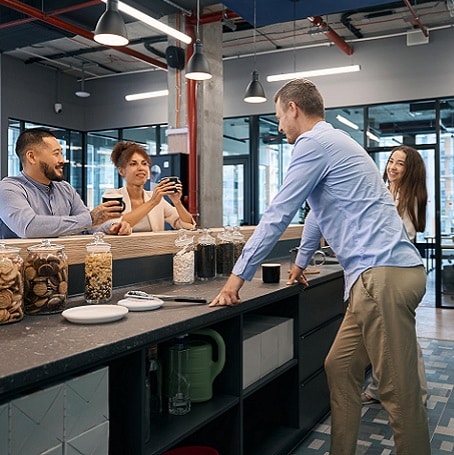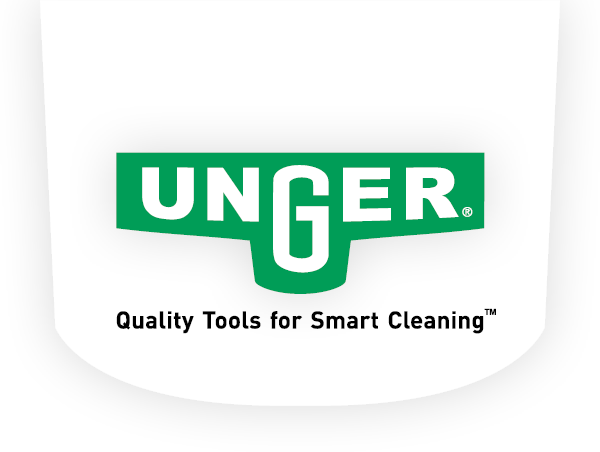NEW! Powerful Nano Filtration with Unger's HydroPower® Nano See The Product

Is the Employee Breakroom Doing More Harm Than Good?
Often Underrated, Breakroom Cleaning Can Impact a Company’s Bottomline
Who doesn’t look forward to a little ‘water cooler talk’ to break up the work day? For the most part, an employee breakroom is a place of opportunity. From a business perspective, the breakroom facilitates employee engagement, which in turns helps to improve workplace culture and encourage collaboration. However, on a basic level, it also serves as a kitchen and dining area. Combining food preparation and eating with high touch surfaces and a high volume of employee interaction (in often close quarters), the stage is set for a breeding ground of bacteria. Without a proper plan for breakroom cleaning, an otherwise casual and opportune environment can quickly transform into a risk-filled petri dish.
Three Reasons the Breakroom is Germier than the Bathroom
The workplace is no stranger to the common old, stomach flu and other viral illnesses given the contact between people and with contaminated surfaces. Nor are businesses immune to the impact of employee illness – reduced productivity, increased absenteeism, and increased health care costs.
While you may think that shared office restrooms would harbor the majority of workplace germs, the office break room and kitchen are actually your bigger germ spreading culprits according to a study conducted by Kimberly-Clark Professional, which collected nearly 5,000 individual swabs from office buildings housing more than 3,000 employees. And while restrooms are frequently cleaned and disinfected, the breakroom is oftentimes a different story. Unlike restrooms, businesses don’t necessarily prioritize breakroom cleaning as it’s assumed that they are kept clean, because after all, employees eat in the space.
Adding to the breakroom cleaning problem, these spaces are private – for employees only, not for visitors or other building occupants to see. Unfortunately for the breakroom, this privacy means that they simply do not receive the same level of attention as other public spaces within the facility, such as the restroom, entrance or lobby, for example.
And lastly, a clean break room is extremely dependent on the cleanliness of the employees using it. Namely, are they coming into the space with clean hands before using the microwave, opening the refrigerator, turning a faucet handle, etc.? Employees failing to wash and/or sanitize their hands make it nearly impossible to maintain a healthy breakroom room, and in turn, an overall healthy workplace.
Just How Dirty is the Breakroom?
Food + traffic = one of the dirtiest places in a facility. The following are common items found in a breakroom that also harbor the most germs:
- Microwave – Not only food remnants, but the handle and buttons are touched all the time.
- Faucets and Refrigerator Handles – Touched continually and breed a lot of germs.
- Cotton Dishcloth – Each time there is a spill, this cloth gets wetter and wetter, which bacteria love.
- Trash Receptacle – A germ’s dream come true, especially with discarded food inside.
- Tabletops and Counters — If not cleaned between users, germs will travel from one user to the next.
Breakroom Cleaning that Supports a Healthier Workplace
Consistent, effective cleaning is the key to keeping the breakroom a healthy, enjoyable place for all. And the effort to keep it clean is twofold:
- For Employees:Employees are responsible for executing on simple solutions, such as washing their hands regularly, using hand sanitizers and practicing good surface hygiene whenever using a common space like the breakroom.
- For Cleaning Professionals and Facility Managers:Deeper breakroom cleaning calls for cleaning professionals and facility managers to utilize the right commercial cleaning tools designed to keep the breakroom a welcoming place while also protecting employee health and limiting virus transmission.
Recommended breakroom cleaning best practices and protocols include:
- Microfiber Cleaning Cloths:
With all the high touch services in the breakroom and the continual flow of foot traffic throughout the day, microfiber cleaning cloths are an effective solution for cleaning handles, faucets, knobs, etc. In an independent study conducted by the Environmental Protection Agency (EPA), the EPA found that extremely fine (.37 micrometer diameter) microfiber was both laboratory and clinically tested and proven to remove up to 98 percent of bacteria and 93 percent of viruses from a surface using only water (no chemicals).
Not only does a microfiber cloth help remove potentially harmful germs but eliminating the need for cleaning chemicals also supports better indoor air quality for everyone’s health and safety. Additionally, microfiber is an ideal cleaning material for cleaning inside of the breakroom refrigerator. With people in and out all day, mishandling food is always a risk for creating a breeding ground for foodborne illnesses. Microfiber can help remove bacteria without the use of chemicals that can contaminate the food in storage.
- Minimizing Chemical Spray in Table & Surface Cleaning:
For cleaning tables and counters beyond a simple wipe down, a surface cleaning kit that avoids the introduction of unnecessary airborne chemicals will keep eating and food prep surfaces safer. For example, a surface cleaning tool such as the Unger Stingray is designed to use fewer chemicals (as much as 39%) than a traditional cloth and spray bottle. The Stingray’s unique design also includes an enclosed spray nozzle, which keeps any cleaning chemicals used from becoming airborne in the process.
- Using Only Clean Solution for Floor Cleaning:
With employees moving between areas, so do the germs and debris residing on the facility floors. While floor mopping can improve the level on cross contamination, chances are you may be cleaning with dirty solution. Traditional floor mopping puts the dirt from the floor into the bucket then back to the floor again. The use of a single cavity bucket limits proper floor cleaning because the solution is contaminated with the soiled rinse water.
Dual bucket floor mopping systems not only prevent cross-contamination, but when paired with a microfiber flat mop, are an effective way to clean for health and sanitation. Together, they prevent surface and mop head re-soiling. Compared to a traditional cotton mop head, microfiber mops can reduce bacteria by 96 percent.
Ready to Increase the Health and Hygiene of Your Break Room?
Breakroom cleaning, while it can appear less of a priority than restroom cleaning for facilities, warrants more effective cleaning to keep employees healthy, engaged and most importantly, at work. Sourcing cleaning equipment that’s designed with hygiene top of mind will go a long way in protecting employees from passing illness’ through a central location.
For more than 50 years, Unger has helped facilities address their cleaning needs in an effort to provide the safest, fastest and highest level of clean possible. If we can help you evaluate your cleaning needs and ways to create a more efficient and effective clean, contact us.
